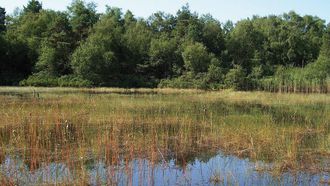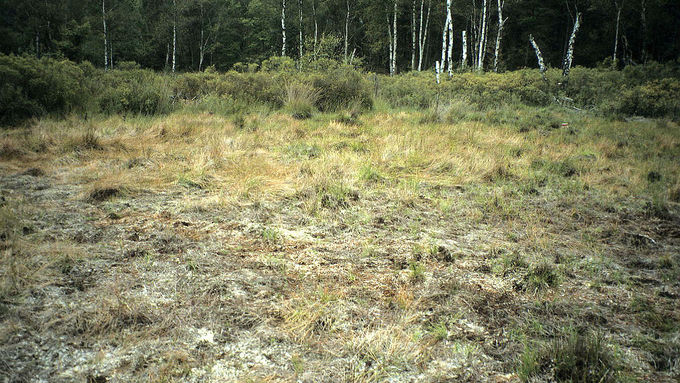Fig. 5: ‘Farger Heideweiher’ with flowering lobelia in July 2007 © M. Diekmann
download picturemain content
Project of the month
#03/2019 FARGER HEIDEWEIHER
Looking outside the box: Standing water body in Bremen
The majority (approximately 80 percent) of the Atlantic region in Germany is located in North Rhine-Westphalia and Lower Saxony, which jointly carry out the EU-funded LIFE Integrated Project ‘Atlantic Region DE’. The remaining area is distributed over the city states of Bremen and Hamburg as well as parts of Schleswig-Holstein and Saxony-Anhalt. The platform ‘Atlantic Region’ platform also involves the other federal states in coordinating and defining a strategy for developing the methodological-conceptual approach to implement the Prioritised Action Frameworks (PAF) and the EU Biodiversity Strategy in the Atlantic region. Thus, the state of Bremen had also declared its support for the joint grant application of the states of Lower Saxony and NRW.
Bremen's portion of habitat types and species which are the focus of LIFE IP is relatively small, but with the ‘Farger Heideweiher’ there is a nationwide significant location in the north of Bremen. It is classified as habitat type 3110: ‘oligotrophic waters containing very few minerals of sandy plains (Littorelletalia uniflorae)’ and part of a glacially dominated landscape with inland dunes. It is part of the Special Area of Conservation ‘Heide und Heideweiher auf der Rekumer Geest‘ (heath and heather pond on the Rekumer moraine (DE 2117-301). Its bank region regularly falls dry in the summer months, but the entire water body only in summers with little precipitation. There still exist – besides many-stalked spike-rush (Eleocharis multicaulis), lesser bladderwort (Utricularia minor), common sundew (Drosera rotundifolia) and others plants – Ranunculus ololeucos and Dortmann’s cardinalflower (Lobelia dortmanna). In Germany, both species have declined sharply because of nutrient input into the nutrient-poor heather ponds which they need. They are classified as ‘endangered’ and ‘critically endangered’ respectively in Germany's new Red List. Due to the surrounding light birch and pine forest, there is no disturbance from wind or waves, nor by the formerly common sheep grazing which keeps the area open and removes nutrients. Therefore, maintenance measures must be taken time and time again to preserve the conservation status of the Farger Heideweiher.
At the end of the 1930s, the construction of an underground mineral oil fuel depot had started there. As a result, as a military area it was no longer accessible for civilians for decades. It was only in 1993 that biological studies could be carried out again: Within the framework of a diploma thesis at the University of Bremen, the occurrences of Ranunculus ololeucos and Dortmann’s cardinalflower were rediscovered. Although the rare flora was known from ancient literature, it had been considered lost since the late 1930s.
Observations and various studies commissioned by Bremen’s nature conservation authority towards the end of the 1990s proved an increasing threat of the botanical rarities of the Farger Heideweiher due to population aging and acidification. Since rare species had previously regenerated from the soil's diaspore stock in connection with securing measures for the oil tanks by pushing off the topsoil in boundary areas, a large-scale stripping of topsoil throughout the heath pond was planned to revitalize the heathland vegetation and to enable the development towards a the lobelia-bearing water body. Initially, however, the scepticism regarding a successful implementation had to be dismantled. After all, the valuable vegetation of a bog pond was to be destroyed in the hope that thereafter the vegetation of a heath pond with even rarer species would appear. In an exemplary cooperation of Bremen’s nature conservation authority, the German Federal Forestry Agency, the Federal Armed Forces / base administration Schwanewede, IVG Logistik GmbH Tanklager Farge (as operator of the fuel depot), the nature conservation measure was implemented in the fall of 1999 (Fig. 1 to 4). From a botanical point of view, in the following years the waters developed into a very valuable typical heath pond (Fig. 5), which provides habitat to numerous endangered species, such as yellow-spotted whiteface (Leucorrhinia pectoralis), crested newt (Triturus cristatus), moor frog (Rana arvalis) and common spadefoot (Pelobates fuscus). Already in the first year after the action almost all heath plants which had been hoped for appeared on the stripped area again. Some other species appeared only for one or a few years and then disappeared again, such as the floating water-plantain (Luronium natans) or the gypsywort (Lycopus europaeus). In the late summer of 2009, another section of the dry peat moss was stripped to re-open sandy soil areas.
By 2011, the lobelia population developed positively. From 2013, however, the density of individuals gradually decreased. One of the signs of a general deterioration was the fact that habitats that were formerly dominated regularly by lobelia only had a few or no specimen in 2013. Instead, these areas were 100 percent overgrown with sphagnum. The main problem for the decline in lobelia has been the increasing acidification, the continuing growth of sphagnum and the resulting gradual displacement of shoreweed vegetation. Therefore, by carefully applying hardly soluble dolomitic lime, the pH value, which was between 4 and 5, should be slightly increased, without causing a significant increase in pH and subsequent eutrophication. At the end of August and beginning of September 2016 as well as in September and December 2017, a total of 725 kilograms of lime were spread on the bank in four portions. Immediately thereafter, an increase in pH to values between 6 and 7 was recorded. Also in May 2017, relatively high pH values between 5.1 and 6.0 were measured. It remains to be seen whether the liming leads to higher pH values in the longer term.
To address the problem of a re-existing dense sphagnum cover, the heath pond was stripped again in the late summer of 2018 after falling dry. For this purpose, as in 1999, the entire sphagnum cover was removed up to the sand, with some smaller areas which still had occurrences of Dortmann’s cardinalflower and Ranunculus ololeucos being omitted as initials for proliferation (Figs. 6 to 8). In addition, the area was slightly increased by removing emerging shrubs and reeds in the boundary area. Since the ‘Heideweiher’ still lies in a restricted military area, disturbances by people looking for recreation, free-running dogs, etc. or other negative influences are excluded.
additional information
Further links (in German)
- Naturschutzbehörde Bremen (external link opens in a new window)
- „Eispohl, Sandwehen und Heideweiher“ bei „Erlebnisraum Natur“, den Info-Seiten zu den Bremer Naturerlebnissen (external link opens in a new window)
- Faltblatt: Eispohl, Sandwehen und Heideweiher – Schutzgebiete im Land Bremen (external link opens in a new window)
- Pflege- und Managementplan (PMP) für das FFH-Gebiet „Heide und Heideweiher auf der Rekumer Geest“ (2011) (external link opens in a new window)





